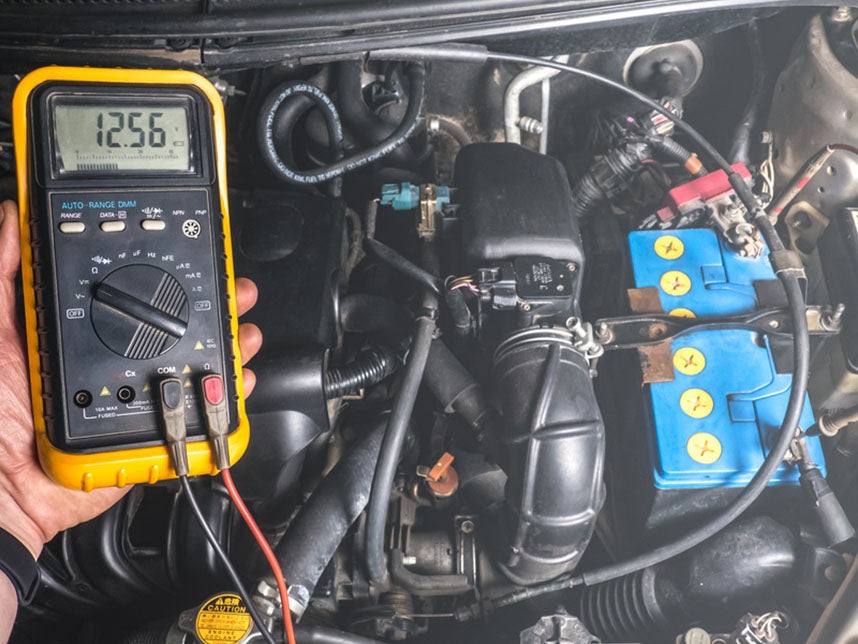A dead car battery can halt your journey instantly. Knowing how to check your car battery’s health is a valuable skill for any car owner. Using a multimeter, a simple and inexpensive tool, you can quickly assess the condition of your battery and diagnose potential charging system issues. This guide will walk you through the process of testing your car battery with a multimeter, ensuring you can confidently determine if your battery is the culprit behind your car troubles.
Preparing to Test Your Car Battery
Before you begin, it’s important to ensure accurate readings. For the most reliable results, test your car battery after it has been at rest for at least an hour – this is known as the “resting voltage”. Ideally, an overnight rest will provide the most accurate gauge of your battery’s state of charge. Recent driving, especially if your car’s charging system is functioning correctly, can result in a temporarily higher voltage reading, which may not reflect the true resting state of your battery.
 Checking car battery voltage with a multimeter
Checking car battery voltage with a multimeter
To get started, you’ll need to access your car battery terminals. In most vehicles, the battery is located under the hood, typically on one side of the engine compartment. If you’re unsure of its location, your car’s owner’s manual will provide guidance. Modern cars often have a plastic cover over the battery, which may unclip, hinge open, or require removal using a few bolts or screws. You might also find a red cover specifically protecting the positive (+) terminal.
Once the battery terminals are accessible, exercise caution. Ensure no metal objects come into contact with the terminals to prevent accidental short circuits. Avoid placing tools or wrenches directly on top of the battery.
Step-by-Step Guide: Testing Car Battery Voltage
To test your car battery’s voltage, follow these steps using your multimeter:
-
Set Up Your Multimeter: Your multimeter needs to be set to measure DC voltage. Look for the ‘V’ symbol with a straight line above a dashed line. Set the multimeter dial to the 20V setting. This setting allows for accurate measurements within the 0-20 Volt range, which is suitable for car batteries.
-
Connect the Multimeter Probes: Identify the positive (+) and negative (-) terminals on your car battery. They are usually marked clearly, and the positive terminal cover is often red.
- Connect the red probe of your multimeter to the positive (+) terminal.
- Connect the black probe of your multimeter to the negative (-) terminal.
If you accidentally reverse the probes, you’ll get a negative voltage reading (e.g., -12.6V instead of 12.6V). This simply indicates reversed polarity and doesn’t damage anything, just correct the probe placement.
-
Read the Resting Voltage: Observe the voltage reading on your multimeter. A healthy, fully charged car battery should read approximately 12.6 volts or higher.
- 12.6V or above: Indicates a fully charged and healthy battery.
- 12.4V: Represents approximately 75% charge.
- 12.2V: Indicates a 50% charge. A battery at this voltage is considered significantly discharged.
- Below 12V: The battery is considered discharged. If your battery consistently reads below 12V after resting and charging, it may indicate a problem.
It’s important to consider “parasitic drain,” a common issue in modern vehicles. Even when the engine is off, systems like clocks, computers, and alarms draw small amounts of power. If you suspect parasitic drain is depleting your battery, consider disconnecting the battery or using a battery maintainer, especially if the car is stored for extended periods.
If your multimeter reading is below 12.6 volts, disconnect the battery from your car and use a battery charger to fully recharge it. After charging, let the battery rest overnight again, disconnected from the car. If the battery holds a charge while disconnected, but quickly discharges when connected to the car, it suggests a parasitic drain issue or a problem within the car’s electrical system, rather than the battery itself.
Testing Your Alternator with a Multimeter
The alternator is responsible for charging your battery while the engine is running and powering your car’s electrical systems. To check if your alternator is functioning correctly, perform a voltage test with the engine running:
-
Start Your Engine: Ensure your car is in a well-ventilated area and start the engine. Be mindful of moving parts under the hood while the engine is running.
-
Test Charging Voltage: With the engine idling at a normal speed, repeat the voltage test as described above, connecting the multimeter probes to the battery terminals.
- Ideal Range: 13.8V to 14.4V: A reading within this range indicates a healthy charging system. The alternator is properly charging the battery and supplying power.
- Below 13.8V: Suggests undercharging. The alternator may not be producing enough voltage to charge the battery effectively. This could be due to a faulty alternator, loose belt, or wiring issues.
- Above 14.4V: Indicates overcharging. This can damage the battery over time by causing it to overheat and lose electrolyte. Overcharging is often a sign of a voltage regulator problem within the alternator.
Readings outside the 13.8V to 14.4V range indicate a problem with your charging system that requires further investigation to prevent battery damage and ensure reliable vehicle operation.
Understanding Dead Battery Cells
While you can’t repair dead cells in a modern car battery, recognizing the signs can help diagnose battery issues. A slow engine crank during starting is a common symptom of dead battery cells. Car batteries typically degrade over time, with individual cells within the battery failing. Testing the resting voltage, as described earlier, is generally sufficient to identify battery health issues, including those caused by dead cells.
Older, non-sealed batteries sometimes allow access to individual cells. These cells contain a mixture of water and sulfuric acid. Specialized tools like a hydrometer can test the specific gravity of the electrolyte in each cell to identify dead cells. However, this is rarely necessary with modern maintenance-free batteries, and voltage testing provides a simpler and equally effective diagnosis for most car owners.
Pro Tip: Before disconnecting your car battery for any reason, remember to check if you need the anti-theft code for your car stereo. Disconnecting the battery can sometimes reset the stereo system, requiring you to enter the code to restore its function.
